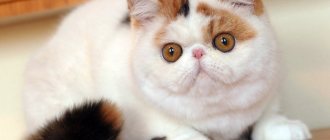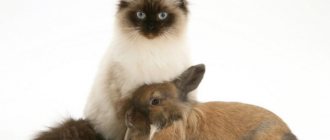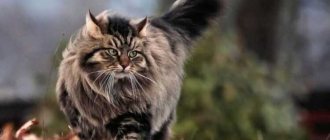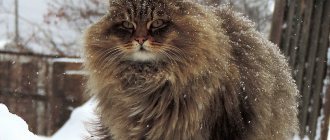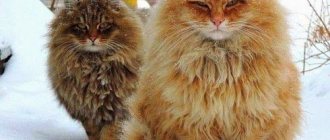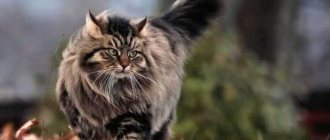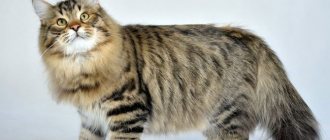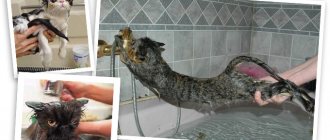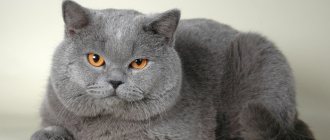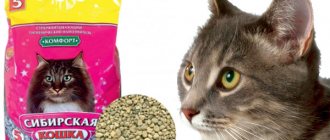Siberian cats are spectacular and powerful animals with a luxurious coat and a unique disposition. They very organically combine developed hunting instincts, beautiful exterior and high intelligence.
Let's figure out what features are hidden behind the respectable appearance of Siberian cats and how to make living together with them as comfortable as possible.
Brief history of the breed
The first mentions of large cats from Siberia date back to the 16th century. Presumably they came to these lands with Asian traders from Bukhara or together with settlers from the western part of Russia.
Experts are convinced that these animals mated with forest cats in their natural environment, as a result of which their descendants developed thick, long hair that could reliably protect them from the harsh climate.
Selection work to consolidate the best qualities of Siberians began in 1986. To distinguish the breed, felinologists wanted to call it “Moscow semi-longhair”. But since large shaggy cats evoked associations with Siberia, they began to be called “Siberian”.
In 1989, the breed was registered in the USSR. A year later, its standard was sent to leading international felinological associations. As a result, in 1992, Siberians received official status in the WCF. A little later, the breed was recognized by CFA, FIFE and TICA.
Black spotted color of Siberian cats
According to the color system adopted by FIFE and WCF, the harlequin color is designated SIB n 24. Other names for this color are brown spotted, black spotted.
The black spotted coat is often confused with the black brindle. With black spotted cats, there should be clear spots on their sides.
There is a variety of spotted color - “torn marble”. This is a very impressive color. This color is characterized by large spots on the sides.
In some cases, these spots have the appearance of “rosettes”, the middle of which is lighter. This color is similar to the color of breeds that were bred based on the use of wild animals (for example, Bengal cats).
Interesting Facts
During the existence of Siberian cats, many interesting things have been associated with the breed:
- The unique fur of animals of this breed almost never causes allergic reactions.
- The Siberian cat of the famous politician Dmitry Medvedev, named Dorofey, took part in one of the popular TV shows.
- There is a unique place in Tyumen. It is called “Square of Siberian Cats” and is dedicated to the animals who saved priceless exhibits of the Leningrad Hermitage from rats during World War II.
Health
Despite their strong, excellent health, these fluffies are susceptible to disease. Most often, among representatives of this breed there are diseases of the digestive system, heart and blood vessels, kidney failure and allergies.
- Siberians can have allergic reactions to household dust, pollen, and even food.
- Digestive and heart problems are caused by a pet's sedentary lifestyle and poor diet or overeating.
- Symptoms of heart disease include cough and shortness of breath. Siberians are susceptible to periodontal disease.
There is an inheritance of cancer among Siberian cats. This phenomenon mainly occurs in representatives with white fur.
Diseases of the genitourinary system, which can cause kidney failure, are dangerous for Siberians. It happens that a cat accumulates a large amount of hair in its body, some of which it regurgitates. If such problems arise, you need to give the cat a tablespoon of vegetable oil; a teaspoon of oil will be enough for the kitten.
Breed description, standards, appearance
Siberian cats are large animals with strong, muscular limbs and luxurious shaggy hair. Thanks to the luxurious “jabot” and graceful muzzle, representatives of the breed have a presentable lordly appearance. A detailed description of the Siberian cat is presented in the official standard.
Dimensions and weight
Representatives of the Siberian breed are distinguished by their impressive dimensions. Cats weigh about 4-6 kg. The weight of cats varies between 7-10 kg. However, there are cases when the weight of Siberians reached 12 kg.
On a note. Due to developed sexual dimorphism, a cat does not look as representative as a male cat.
Anatomical characteristics
Ideally, a Siberian cat should fit the following description:
- The head is trapezoidal, with a smoothly contoured muzzle, full cheeks, a pronounced chin and low-set, developed cheekbones.
- The ears are medium in size, slightly tilted forward. Wide at the base, gradually tapering to slightly rounded tips.
- The eyes are oval, medium in size. They have a wide, slightly slanting stance. The iris is yellow or green. A white cat of the Siberian breed may have multi-colored or blue eyes.
- The body is dense, massive, slightly elongated. The neck is short, the back is strong, the chest is voluminous.
- The limbs are thick, with developed muscles and large rounded paws. The interdigital space is overgrown with bristly tufts of hair.
- The tail is fluffy, of medium length, wide at the base, gradually tapering to a rounded tip.
Color and coat type
The Siberian forest cat has coarse, dense outer hair and soft, dense undercoat. The shiny awn has water-repellent properties. It completely covers the back and falls evenly onto the sides and base of the Siberian's tail.
On a note. The winter coat of Siberian cats is much longer than the summer coat. During the cold season, they develop a chic collar and fluffy pants. In warm weather, the Siberian can look like a smooth-haired cat.
Cats of this breed have several color options. According to the standard, the color of Siberians can be:
- All different intensities. The main solid colors include red and black. Each of them has a clarified counterpart. Red corresponds to a cream shade, black – gray (blue). The white Siberian cat is considered very rare and cannot have any patterns or inclusions on its fur.
- Tortoiseshell color is a combination of several shades. It is essentially a calico cat with white markings evenly distributed across its body, as well as cream and blue or red and black spots. Tortoiseshell coloring is typical for females. Siberian cats with this color are born extremely rarely and, as a rule, do not give birth.
- Smoky and silver. These Siberians have a two-color coat. Their hairs have a white base and a dyed tip. Silver cats of the Siberian breed have a pattern, while smoky cats do not.
- Tabby (wild). This color is an alternation of dark and light pigment, which creates a spotted, brindle or marbled pattern on the Siberian’s body.
- Chinchilla. This color is rarely found in Siberian cats. Chinchilla hair has 2 stripes: dark at the tip and light at the base.
- Gold. A difficult color to fix, in which the Siberian's fur coat is painted in a warm apricot shade.
Diseases
The Siberian cat has a strong immune system, but this breed also has a number of problems. Most, fortunately, can be dealt with, you just need to seek help in time.
- Periodontal disease is a common disease among Siberians. The reason is the distant crossing of the forest Siberian breed with the Himalayan and Persian cats to consolidate physical characteristics. The provoking factor is poor nutrition and poor oral hygiene control by the animal owners. Damaged teeth have to be pulled out.
- Oncology – occurs in Siberian cats with white fur. With timely diagnosis and treatment, the animal lives quite a long time.
- Polycystic kidney disease is diagnosed in older cats. Cysts begin to grow, which gradually fill with fluid and negatively affect the functioning of the kidneys. There are no preventive measures, so animals with poor heredity should not be bred.
- Kidney stones and other pathologies of the lower urinary tract. Almost all are treatable.
- Hypertrophic cardiomyopathy is a thickening of the heart muscle. In Siberian cats, even kittens suffer from the disease (in other breeds, the disease manifests itself in old age). It cannot be cured, but early diagnosis and supportive therapy can prolong the cat’s life for many years.
If your pet begins to hide in corners, eats poorly, behaves restlessly, or vice versa - moves little, vomits or blood is found in its feces - immediately take the cat to the veterinarian!
Expert opinion
Dusheba Vera Ivanovna
In 2010, she graduated from the Moscow State Academy of Veterinary Medicine named after K.I. Scriabin with honors, specializing in veterinary medicine. I regularly attend veterinary conferences, congresses, and webinars.
Do not ignore vaccinations, even if your pet lives in an apartment and does not come into contact with other animals. The causative agents of plague, chlamydia, viral rhinotracheitis and the like can be brought into your home very simply: on your shoes or clothing, on your hands and other objects. The first vaccinations are given to babies at 3 months, they are first given an anthelmintic drug (7-10 days before the procedure), and revaccination is done a month after the first vaccination. Keep in mind that this is a burden for a small organism, so if your pet is sick, or his teeth are changing, or he needs to be transported to a place with a different climate, postpone vaccination for a while.
In the photo there is a Siberian cat on a walk
Character and temperament
Siberians are active and playful cats with a developed sense of self-esteem. They are very reserved, talkative and subject to sudden mood swings. Representatives of the breed do not like it when communication is forced on them, but they themselves will not bother the owner when he is busy.
The proud and independent character of the Siberian cat does not interfere with getting along well with all members of the household, including children. The main thing is that the child understands that the animal is not a toy and knows how to properly handle the pet.
Siberians get along well with dogs and other cats. Despite their strong character, representatives of the breed do not strive to dominate other pets. True, the innate habits of a hunter prevent Siberians from being calm around rodents.
How to choose the right kitten
To avoid becoming a victim of scammers, it is better to look for a potential pet in certified nurseries or trusted breeders. It is advisable to buy a Siberian no earlier than he is 3-3.5 months old. By this age, he will already have all the vaccinations and documents confirming his breed.
Kittens should be curious, well-groomed and moderately well-fed. They should not have a bloated belly, sour eyes, matted hair, foul mouth, discharge from the ears, dirt under the tail or scratching on the skin.
Kitten care
Responsible breeders do not separate babies from their mother before they are 3 months old. Therefore, by the time the Siberian kitten moves to a new home, it is already quite independent. He is litter box trained, knows how to use a scratching post, and eats many foods with gusto. The owner can only give the pet time to get used to the new environment and show where its bowls, toilet and place to sleep are.
In order for the little Siberian to adapt faster, they communicate and play with him more often. And so that the kitten’s curiosity does not lead him to trouble, all wires, household chemicals, small objects and indoor plants are hidden in the house. Also, for safety reasons, do not leave windows, oven doors or washing machines open.
Care and maintenance
The Siberian is a long-haired cat adapted to harsh climates. You can keep it not only in an apartment, but also in a private house with access to a yard. Caring for a Siberian cat is generally simple and comes down to basic hygiene and proper feeding.
Hygiene procedures
To make a Siberian look attractive, you need to properly care for him:
- The eyes and ears of representatives of the breed are wiped daily with a moistened cotton swab and inspected for the presence of unusual discharge. If pus is detected, the Siberian must be taken to the veterinarian.
- A cat's claws usually wear down naturally. But if necessary, they are shortened with a nail cutter so as not to damage living tissues and not cause pain to the Siberian.
- The cat's teeth are cleaned weekly with a non-foaming paste applied to a silicone brush or a special attachment.
Grooming
The shaggy Siberian requires more careful care than any short-haired cat. His thick coat is combed weekly with a special comb. During the molting period, the procedure is carried out more often in order to quickly remove dead hairs and keratinized skin scales.
The thick coat of the Siberian cat does not require frequent washing. But sometimes you can’t do without bath procedures. The Siberian is washed in a large basin with warm water. First, the cat's fur is thoroughly wetted, and then soaped and rinsed. The bathed cat is wrapped in a large towel, dried and released so that it is completely dry.
On a note. It is better to wash a Siberian black cat with a special shampoo for charcoal fur, which helps restore its natural color.
Tray
Siberians are large animals, so it is advisable to use a spacious closed tray as a toilet for them. But the type of filler is not so important. The main thing is that it copes with its functions and that the Siberian cat likes it.
Buy a Siberian kitten
It is clear why the Siberian cat has become so popular in Russia and other countries of the world: its external characteristics attract the attention of numerous fans of cats with long hair.
There are enough nurseries where you can buy pedigree Siberians to avoid purchasing a cat with a provenance of dubious quality. If you pick up a kitten from your hands, there is a high probability that it will grow up not into a proud Siberian, but, at best, into a Norwegian forest cat, if you're lucky.
Siberian catteries offer to pre-book a kitten of a suitable class. On average, the cost of the Siberian breed is not particularly high by the standards of the cat market. Purchase cats aged 2.5-3 months, vaccinated and healthy, with the pedigree indicated in the metrics. Buying an inexpensive pet from someone who is supposedly of this breed is fraught with the lack of any documents at all.
The price for cats of the Siberian breed starts at a threshold of 5,000 rubles
and depends on the exterior of the animal and the characteristics of its pedigree.
What to name a Siberian kitten
Choosing a name for a new family friend can sometimes be difficult. When giving a kitten a nickname, people must understand that it should not only please them, but also suit the animal, its external characteristics, and habits. Most importantly, the Siberian cat should easily perceive its name, and, therefore, respond to it easily.
global $ads_google; //data-ad-slot=”2475549904″ $ads_google = empty($ads_google) ? false : true; ?> if ($ads_google == false) {?> $ads_google = true; ?> } ?>
It’s better to come up with a nickname in advance, as the nursery will ask you what name to put on your passport. Many breeders, by old custom, expect the name to reflect the pedigree.
Names for boys and girls can be different, or they can be completely similar. It is worth sitting down and discussing with the whole family what is the best name for a Siberian cat , for this you should use a list of the best nicknames.
Name table
| Girl | Boy | ||
| Redhead Squirrel Cassie Frosya Dara Bonna Athena Mina Shiba Pusha Chunya Laska Eva Zira Rikki | Finn Vyusha Nyusha Rady Basya Vetka Fenya Lada Pear Chishka Dora Plyukha Fanta Kama Era | Chester Maurice Yust Ty Argon Archie Axel Cyber Cruz Bucks Miguel Smokey Pat Fluff Ivor | Erema Patrick Norman Light Evrik Samson Sam Charlie Shrek Cupcake Yukki Veles Karen Murik Nord |
Feeding the cat
An important characteristic of the breed is that it is not picky about food. Siberian cats eat with appetite everything that is given to them, and often beg for more. To avoid the development of obesity, it is advisable not to overfeed them.
Complete diet
Siberian cats can be fed both industrial and natural food. When purchasing drying products, it is recommended to give preference to high-quality premium or super-premium products without any questionable ingredients.
This can be food from the following brands:
- Royal Canin;
- Farmina;
- Bosch;
- Grandorf.
With a natural type of feeding, a Siberian's diet should consist of 70-80% lean fresh meat such as beef, chicken, rabbit or turkey. The cat is also given:
- boiled vegetables;
- offal;
- boiled eggs;
- dairy products;
- porridge with water;
- lean sea fish.
A Siberian cat should not be fed pork, sausages, smoked meats, sweets or baked goods. Also, she should not be given bones, river fish or any food from the master’s table.
On a note. The Siberian Blue cat should not be fed supplements that contain shellfish products and algae. These components contribute to color changes and the acquisition of an unsightly shade.
Feeding frequency
Siberian kittens eat less, but more often than adult representatives of the breed. Therefore, when drawing up a feeding schedule, you should focus on the pet’s age:
- up to 3 months – 6 times a day;
- 3-6 months – 5 times a day;
- 6-9 months – 4 times a day;
- 9-12 months – 3 times a day.
After the Siberian cat turns 1 year old, she is transferred to twice feeding.
Vitamins and minerals
If a Siberian cat eats dry food, it does not need additional feeding. An animal that eats natural foods is given vitamin and mineral complexes in courses twice a year. Drugs are selected on the recommendation of a veterinarian and taking into account the general condition of the cat’s body.
Catering
If you feed an animal based only on its tastes - for example, only meat or fish - sooner or later its metabolism will be disrupted, problems with its kidneys, fur and teeth will arise. Therefore, remember the following rules:
- A healthy Siberian cat is fed 2 times a day: morning and evening. Serving size: 30-60 g per kg weight). A pregnant, lactating individual, with chronic diseases or an old one can be fed 3 times, or the portions can be increased.
- In addition to food and water, they grow grass (you can buy it at a pet store). The animal will come to her when he wants. The weed helps cleanse the stomach and is also an additional source of folic acid, vitamins and fiber.
Natural products
What is included in the diet if you choose natural food.
- Meat - all varieties: streaky beef, lean lamb, rabbit, turkey, veal, lamb. The meat is pre-frozen, and before feeding, it is doused with boiling water and cut (or minced). It is better to boil chicken. Bones, tripe and skin are not given; lard, duck and goose meat, and pork are also prohibited.
- Offal: heart (boiled), liver (stewed or boiled), kidneys and lungs (boiled), udder (a little fatty, so you can give it occasionally).
- Fish - sea varieties. These are flounder, tuna, hake, trout, cod, salmon. Raw fish causes intestinal upset and negatively affects the appearance, so the product is boiled or stewed. Fatty varieties - herring, mackerel, sprat - can be given rarely. Canned fish from pollock and cod - little by little and as a delicacy.
- Chicken eggs - boiled and only the yolk. Raw eggs are poorly digested by Siberians. Quails can be given whole.
- Dairy products: cottage cheese (with whey or egg yolk), fermented baked milk, sour cream, Varenets, natural yogurt, unleavened cheese. Products with dyes and pieces of fruit are prohibited. Whole cow's milk is given only if the cat does not have a negative reaction to it: diarrhea or vomiting.
- Vegetables: beets, carrots, pumpkin, green peas, cabbage (kohlrabi, cauliflower and white cabbage), some gourmets like to nibble on cucumbers and tomatoes. Vegetables are stewed and added to the porridge, rubbed with vegetable or olive oil.
- Cereals: oatmeal, rice, buckwheat, barley, pearl barley. Porridge is cooked in water or diluted milk, without sugar or salt.
- Fruits are not a necessity, but are allowed as a treat. Treat your pet to a piece of melon or apple or strawberry.
- Greens: parsley, dill, green salad, fresh nettle scalded with boiling water.
- Rye bread – a small piece once a week is enough. Bone meal is given if the cat refuses dairy products.
You cannot give:
- Dog food;
- Human vitamins;
- Sweet, smoked, salty, baked goods, flour;
- Tea, coffee, sparkling and mineral water, coffee, juices, alcohol;
- Eggplants, grapes, citrus fruits, legumes.
A piece of sugar-free cookie can be given as a reward, for example, during training.
Expert opinion
Dusheba Vera Ivanovna
In 2010, she graduated from the Moscow State Academy of Veterinary Medicine named after K.I. Scriabin with honors, specializing in veterinary medicine. I regularly attend veterinary conferences, congresses, and webinars.
Choose bowls for water and food that are shallow and stable. If you feed your cat natural food, you should wash the dishes after each meal. After dry food - once a week. Water should be freely available, clean and at a comfortable warm temperature. You can't pour from the tap! Give your cat bottled water or use tap water at home. If there is no fresh water in the bowl, the “Siberian” will climb into the toilet or try to open the tap on its own.
Recommended food
Industrial prepared food is divided into 4 groups.
Economy class food is the cheapest, but also the most stupid. Made from food waste, they contain a small amount of vitamins. TerraCat, Friskies, Perfect Fit.
Premium food is somewhat of a higher quality, but the percentage of meat is low, and the vitamins and minerals are not enough for the animal to fully exist. Mnyams, Night Hunter, Native food.
Super-premium and holistic food is made from high-quality products and contains the necessary minerals and vitamins for the growth and development of the animal. But such food is not cheap. Examples: super-premium - Brit Care, Leonardo, Vet Life; holistic - Jaguar, Nutram, Naturea.
Below are recommended super-premium foods. Links with the names of the food are clickable, on them you can, within our website, get acquainted with the descriptions of the food and read reviews from the owners of the Siberian cat breed.
| Holistic | Super premium | Premium |
| Acana | Brooksfield | Royal Canin |
Education and physical activity
Siberian cats are very smart animals. They quickly remember the rules of behavior in the house, learn to use a scratching post and go to the tray.
Siberian cats have a fairly active temperament. Therefore, it is advisable to provide them with regular walking. If this is not possible, then houses for cats of this breed will be equipped with a special corner with ladders and multi-level shelves. And to realize their hunting instincts, Siberians buy interactive toys.
Color of Siberians
The color of a Siberian cat can be either uniform or patterned. The standard colors are black, red, striped and smoky.
- Black is characterized by black stripes between which there may be gray, brown or red fur.
- Red. It can be of a red hue and tortoiseshell, that is, black and red.
- Striped. It is distinguished by the presence of stripes on the paws and tail and their complete absence on the body.
- Smoky. The appearance of a grayish tint is given by the white undercoat.
In addition, there are many different colors. For example, tabby, when each hair is colored in a light and dark shade, as a whole, forming a pattern. Tabby comes in three varieties: marbled, brindle and spotted.
Golden cats look great when every hair is apricot-colored. White color is very rare among Siberians, but it looks beautiful. This photo shows a Siberian cat with a smoky color.
Vaccinations and antiparasitic treatment
To prevent infectious and viral diseases, Siberians are regularly administered a complex vaccine that stimulates the development of immunity to calcivirosis, rhinotracheitis and panleukopenia.
The kitten is first vaccinated at the age of 7-8 weeks. After 4 weeks he is vaccinated against the same diseases and against rabies. Subsequently, the Siberian is vaccinated annually.
To prevent diseases spread by parasites, the cat is systematically treated for fleas and helminths. Antihelminthic tablets are given to Siberians once every six months with mandatory repetition after 10-14 days. Drugs are selected taking into account the weight of the animal.
Siberian cats are treated against fleas with special shampoos or drops. Regularly walking representatives of the breed are additionally protected with anti-parasitic collars.
External characteristics
According to the World Federation, the description of the Siberian cat breed is as follows:
- weight from 6 kg (some males can reach 10-12 kg);
- height 30-40 cm at the withers, proportional to weight;
- various colors;
- life expectancy up to 20 years;
- notes of independence in character;
- a combination of attachment to the owner with suspicion of strangers;
- high degree of protective instinct;
- ability to remember and learn.
Siberians are classified as breeds with semi-long hair.
Unlike other felines with similar characteristics, they are hypoallergenic.
Pros and cons of the breed
Like representatives of any other breed, Siberian cats have both positive and negative traits.
| pros | Minuses |
| Attractive appearance | Heavy shedding |
| No hereditary diseases | Wayward character |
| Unpretentiousness |
Siberian cats are large and powerful animals with luxurious fur and an independent disposition. They are full of self-esteem and make a wonderful companion for those who are willing to put up with their heavy shedding and frequent mood swings.
Conclusions about the breed
The Siberian cat received the right to wear a unique fur coat, which turned out to be easy to care for. The kitty takes excellent care of her coat herself. Another advantage of the breed is its high health indicator, provided that it is well cared for by the owner.
In a family, a cat quickly becomes a friend to every member of the household: it plays with children, gets along with other pets, and unobtrusively offers its company to everyone. In return, she expects only affection and attention!
